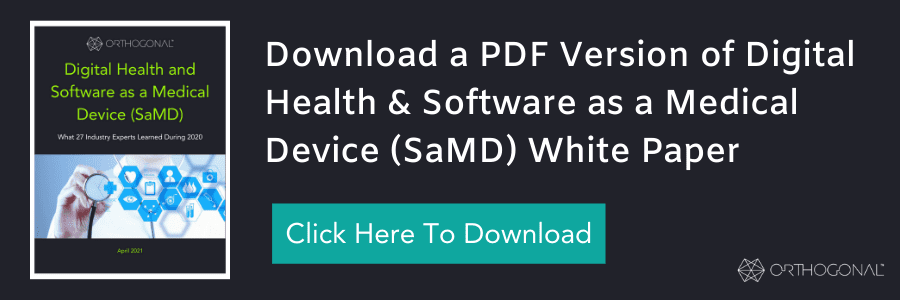
Article
Help Us Build an Authoritative List of SaMD Cleared by the FDA
We didn’t predict at the beginning of 2020, but this has been one heck of a year in healthcare and life sciences, especially in terms of digital health, connected care, and Software as a Medical Device (SaMD).
We’ve all certainly learned a lot. Curious what others have learned, we’ve been reaching out to a wide range of industry leaders, thinkers, and pioneers involved in digital health, MedTech, and Software as a Medical Device (SaMD), health informatics, and related domains asking them to share with us what they learned this year.
Our experts come from various organizations, including Kicker Ventures, Prysm Institute, Orthofix, and Eko. Their responses covered a range of topics from technological innovation to the nature of the physician-patient relationship.

Tomoko Ishikura is a Partner at Kicker Ventures.
What has been your biggest lesson learned during 2020 in terms of digital health, SaMD, and MedTech?
“The structure of the healthcare industry completely shifted and digital health has become one of the established industries. The players in digital health are playing as big of roles as pharma and MedTech players, and FDA and CMS have finally acknowledged this shift to make changes for themselves. The fund is flooding into digital health”.
Which organization, trend, or person was not high on your radar at the beginning of 2020 for digital health and MedTech innovation but is now? Why?
“Cox Communications – they’re using their advantage to go inside the people’s house to set up the cable to get into home healthcare.
Wen Dombrowski at Catalaize – she’s so knowledgeable in cognitive diseases and has ability to come up with very practical solutions in digital health”

Dr. James J. Gillespie is the Executive Director of the Prysm Institute.
What has been your biggest lesson learned during 2020 in terms of digital health, SaMD, and MedTech?
“Here’s one thing I’ve learned this year: Digital health has rapidly transformed from a ‘nice to have’ to a lifeline for many patients –and even providers– as technology like AI and robotics moves robustly into healthcare systems and into homes. More rapidly than anticipated because of Covid-related amplification, human-machine collaboration is going to quickly become integral to quality, affordability, and access in medicine. Because of this, the stakes for technological innovation have never been higher.”

What has been your biggest lesson learned during 2020 in terms of digital health, SaMD, and MedTech?
“My biggest lesson learned in 2020 with regards to gaps in Digital Health has been how the data was so fragmented it nearly inhibits all use for communication. With only 8% of adults ever trying telehealth, I think that speaks to the antiquity of our medical system where mass adoption of technology is related. The lack of a “USB 3.0”-type universal platform for data sharing and integration sets us back a great deal when it comes to executing an effective integrated data strategy in healthcare.”
Which organization, trend, or person was not high on your radar at the beginning of 2020 for digital health and MedTech innovation but is now? Why?
“Dr. Mohamed Rehman‘s digital twin concept is very interesting to me as it nearly makes you a control and test factor in your own study as well as research data for a larger picture. I think this is important as there is no better baseline than your own for allowing immediate indications of procedure variance”.

Jeff Culhane is the Senior Vice President of Product Development at Orthofix.
What has been your biggest lesson learned during 2020 in terms of digital health, SaMD, and MedTech?
“Remote Patient Monitoring and Telehealth markets have become crowded in a short period of time with the creation of specific CPT codes for billing for the review of patient data or providing a device to monitor or transmit data. The distinction between the two is subtle but simple, RPM does not enable communication between the patient and physician. The minimum viable product offering needs to carefully consider chronic vs episodic care and if there is generic or differentiated product data or patient information to leverage. In a crowded market, the product offering needs to be specific and differentiated in a meaningful way.”
Which organization, trend, or person was not high on your radar at the beginning of 2020 for digital health and MedTech innovation but is now? Why?
“Zimmer Biomet’s mymobility application has expanded from total joints into spine. This platform has the potential to transform patient care and set a new standard.”

Dr. Adam Saltman is the Chief Medical Officer at Eko. Dr. Saltman is a Triple Board-certified cardiothoracic surgeon and a former medical officer at the FDA.
What has been your biggest lesson learned during 2020 in terms of digital health, SaMD, and MedTech?
Digital health can take many forms, but it always comes down to meeting the clinicians’ and patients’ needs. At Eko, we rapidly expanded our telehealth offering to meet the needs of patients who could not see their healthcare provider in person, and also of providers who needed to maintain their PPE integrity while examining patients with suspected COVID. We are using those platforms to gather the data we need to improve our current AI/ML offerings and to develop new ones, always aimed at improving the quality of care offered to patients remotely”.
Which organization, trend, or person was not high on your radar at the beginning of 2020 for digital health and MedTech innovation but is now? Why?
“Following up from the first question, telehealth has moved very high on our radar. Although no one really knows at this point where the utilization of telehealth will settle after the pandemic, it is clear that the early phase of ultra-rapid adoption is over and users – both patients and providers – are demanding telehealth tools that provide an experience much closer to a real in-person visit. This will require better hardware, of course, but the real advances will come from better AI/ML SaMD that can both screen for disease and help providers manage their patients with chronic disease”.
Over the next few weeks, we will be releasing more blogs sharing the replies from other experts. You can follow this series using #DigitalHealth_SaMD_2020 on Twitter and LinkedIn, or sign up for our newsletter.
Related Posts

Article
Help Us Build an Authoritative List of SaMD Cleared by the FDA

Article
SaMD Cleared by the FDA: The Ultimate Running List

White Paper
Software as a Medical Device (SaMD): What It Is & Why It Matters

Article
Predetermined Change Control Plans: Seizing the Opportunity